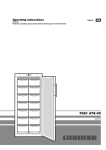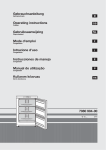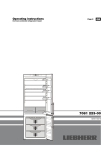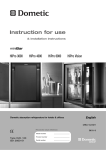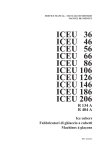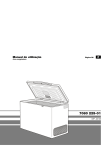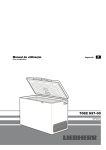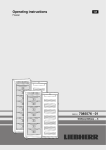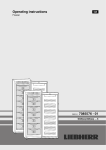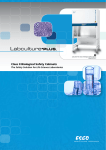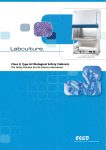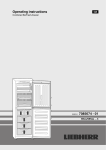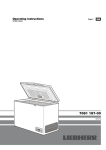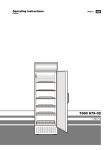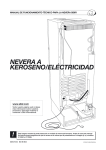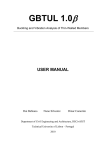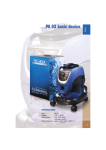Download KGNVes 5066 user manual
Transcript
Operating instructions
GB
combined refrigerator-freezer
7080 327-00
KGN 103
Disposal notes
Safety instructions and warnings
The packaging is made of recyclable materials.
- Corrugated board/board
- EPS moulded parts
- Polythene sheets
- Polypropylene straps
• To prevent injury or damage to the unit, the appliance should be
unpacked and set up by two people.
• In the event that the appliance is damaged on delivery, contact
the supplier immediately before connecting to the mains.
• To guarantee safe operation, ensure that the appliance is set up
and connected as described in these operating instructions.
• Disconnect the appliance from the mains if any fault occurs. Pull
out the plug, switch off or remove the fuse.
• When disconnecting the appliance, pull on the plug, not on the
cable.
• Any repairs and work on the appliance should only be carried out
by the customer service department, as unauthorised work
could prove highly dangerous for the user. The same applies to
changing the mains power cable.
• Do not allow naked flames or ignition sources to enter the
appliance. When transporting and cleaning the appliance ensure that the refrigerant circuit is not damaged. In the event of
damage, make sure that there are no ignition sources nearby
and keep the room well ventilated.
• Do not stand on the plinth, drawers or doors or use them to
support anything else.
• Do not let children play with the appliance, e.g. do not allow them
to sit in the drawers or swing on the doors.
• Do not eat ice cream, particulary ice lollies or ice cubes,
immediately after taking them from the freezer compartment as
there is a risk of "burning" because of the very cold temperatures.
• Do not consume food which has been stored for too long, as it
could cause food poisoning.
• The appliance is designed for cooling, freezing and storage of
food, and for making ice and is intended for domestic use. If used
for commercial purposes, the relevant legal regulations applicable to the trade concerned must be observed.
• Do not store explosives or sprays using combustible propellants
such as butane, propane, pentane etc. in the appliance. Electrical components might cause leaking gas to ignite. You may
identify such sprays by the printed contents or a flame symbol.
• Do not use electrical appliances inside the appliance.
• Please return the packaging material to an official collection
point.
• Do not dispose of discarded appliances with bulk refuse.
• Disable discarded appliances by removing the plug and cutting
through the connection cable. Render the catch unusable so
that children cannot become trapped inside.
• Ensure that the refrigerant circuit is not damaged when the
appliance that is no longer needed is taken away for disposal.
• Details of the refrigerant used can be found on the type plate.
• Information on collection dates or collection points can be
obtained from the waste disposal authorities or local council.
Contents
Page
Setting up / Connecting to the mains
Notes on energy saving / Dimensions
Switching the appliance on and off
Setting the temperature / Child-proof lock ......................... 9
Temperature display / Audible warning signal
Power failure "frost-control" display
Supercooling
Equipment / Interior light .................................................. 10
Cooling
Freezing / Storage / Making ice cubes
Freezing with Superfrost
Freezing chart ................................................................... 11
Notes on freezing and storage
Defrosting / Cleaning ........................................................ 12
Malfunctions / Shutting down
Changing over door hinges
Installing appliance in a row of kitchen units .................... 13
Operating and
control elements
Butter
and
cheese
compartment
Adjustable door racks
Adjustable shelves
Type plate
Vegetable bins
Drawers
Freezing chart
Adjustableheight feet
8
Please read all the information contained in these operating
instructions carefully. It includes important notes on the appliance's safety, installation and maintenance. Keep these instructions in a safe place and pass them on to the next owner where
applicable. These instructions describe all the appliance's controls and equipment. Please bear in mind that individual models
may differ slightly from these instructions.
The appliance is set to operate within specific ambient temperature limits according to its climate rating. These temperature limits
should not be exceeded. The correct climate rating for your
appliance is indicated on the type plate.
Climate rating
Ambient temperatures
SN
N
ST
T
+ 10° to + 32 °C
+ 16° to + 32 °C
+ 18° to + 38 °C
+ 18° to + 43 °C
Setting up
Switching the appliance on and off
• Avoid positioning the appliance in direct sunlight or near cookers, radiators and similar sources of heat.
• The floor on which the appliance stands should be horizontal
and level. To compensate for any unevenness, adjust the height
of the feet with the open-ended wrench supplied. The appliance
can be placed with its back flush to the wall.
• The ventilation grilles should not be obstructed. Always ensure
that there is good ventilation and that the outward flowing air is
able to escape.
• Do not place heat-emitting appliances, e.g. microwave oven,
toaster, etc., on top of the appliance.
• Standard EN 378 specifies that the room in which you install your
appliance must have a volume of 1 m3 per 8 g of R 600a
refrigerant used in the appliance, so as to avoid the formation of
inflammable gas/air mixtures in the room where the appliance is
located in the event of a leak in the refrigerant circuit. The
quantity of refrigerant used in your appliance is indicated on the
type plate on the inside of the appliance.
You are advised to clean the appliance before switching it on for
the first time (see "Cleaning").
Switch on the appliance approx. 2 hours before loading it with
frozen food for the first time. Do not load with frozen food until the
temperature shows at least -18°C. The refrigerator and freezer
compartments can be operated separately.
Connecting to the mains
Power supply (AC) and voltage at the operating point must comply
with the details on the type plate, which is located on the inside left
of the appliance, next to the vegetable bins. The socket must be
fused with a 10 A fuse or higher, it must be away from the rear of
the appliance and must be easily accessible.
Connect the appliance with a properly earthed fused plug and
socket only.
GB
Press the on/off buttons (on left for
refrigerator, on right for freezer) so that the temperature
displays light up or flash.
Switching on:
-
The interior light will light up when the door is open.
The alarm will sound when the appliance is switched on
for the first time and when the appliance is "warm".
Refrigerator:
Freezer:
Press the alarm off button to switch it off.
See the "Audible warning signal" for more information.
Press the on/off buttons again so that the temperature displays go out.
Switching off:
Setting the temperature
The appliance is pre-set for normal operation. We recommend
temperatures of +5°C in the refrigerator and -18°C in the freezer.
To reduce the temperature:
The wires in the mains lead are coloured in accord-ance with the
following code: green/yellow = earth, blue = neutral, brown = live.
Press the bottom button; on left for refrigerator and
on right for freezer.
Warning! This appliance must be earthed.
To increase the temperature:
Press the top button.
Notes on energy saving
• Avoid opening the door unnecessarily for long periods of time.
• Store frozen food logically and do not exceed the safe storage
period.
• Allow hot food to cool to room temperature before storing it in the
appliance.
Dimensions
(mm)
- While you are entering the temperature, the set temperature will
flash on the display.
- When you press the temperature setting buttons for the first
time, the most recent setting (known as the "reference setting")
is displayed.
- You can change the settings in increments of 1°C by briefly
pressing the buttons again. If the buttons are held down the
temperature setting will change faster.
- Approximately 5 seconds after the button has been released, the
display will automatically show the actual freezing or cooling
temperature (known as the "actual setting").
- You can change the temperatures
in the refrigerator: between 11° and 2°C and
in the freezer: between -14° and -28°C.
Child-proof lock
The child-proof lock is designed to protect the appliance from
being switched off accidentally.
>+>
3 sec.
Switching on the child-proof lock: Hold down
the audible warning on/off button and then press
the Superfrost button, and keep both buttons
pressed simultaneously for approx. 3 seconds.
A double beep confirms your entry. The LED
Switching off:
will come on.
Press this key combination again; the LED
will
now go out.
9
Temperature display
Equipment
In normal operation, the following settings will be displayed:
- the average refrigerator temperature in display and
- the warmest frozen food temperature in display.
When starting up for the first time or when the appliance is warm,
dashes will appear until the temperature reaches a level that can
be displayed (19° to 0°C in the refrigerator and below 0°C in the
freezer).
The display will flash:
- if you change the temperature or
- if the temperature rises by several degrees, indicating cold loss,
e.g. if you place fresh, "warm" food in the freezer or if you remove
or re-pack frozen food the temperature may rise for a short time
due to warm air flowing into the freezer.
If F1 to F5 appears in the display, the appliance has a fault.
Consult the customer service department indicating the fault
number displayed.
You can re-arrange the storage shelves
as required. Lift up shelves at the front, pull
them out halfway and remove by tilting
upwards or downwards.
When inserting a shelf, the guard bar at the
back must be facing upwards, otherwise
food may freeze to the rear wall.
Repositioning the door racks
- Lift door rack vertically, lift out to the front
and re-insert at a different height, following these steps in the reverse order.
- By shifting the bottle holder you can
protect the bottles from falling over when
opening or closing the door.
Audible warning signal
The audible warning device helps to protect the frozen food and
to save energy.
- It sounds when it is not cold enough in the freezer compartment.
The temperature display will also flash;
- when too much warm air from the outside enters when inserting,
re-arranging or removing frozen food.
The audible warning device is switched off by pressing the
button. The temperature display will continue to
flash until the cause of the alarm has been rectified.
- If you require space for large bottles and
containers, slide one half of the glass
shelf to the back.
"ALARM"
Power failure "frost-control" display
If nA appears in the display, this means that the freezer temperature has risen too high during the last few hours or days due to a
power failure.
If you press the "ALARM" button whilst the display is reading nA,
the highest temperature registered during the power failure will be
displayed. Check the quality of the food and its suitability for
consumption in case it has become too warm or even defrosted.
The highest temperature will appear for appox. 1 minute. After
that, the actual temperature in the freezer will re-appear. The
display can be switched off by repeatedly pressing the "ALARM"
button.
Supercooling
The Supercooling button switches the refrigerator compartment
to maximum cooling. It is recommended particularly if you wish to
cool large quantities of food, drinks, freshly baked cakes or meals
rapidly.
Switching on Supercooling: Press the Supercooling button briefly so that the LED comes on. The refrigerator
temperature will drop to its lowest value.
Note: The Supercooling function uses slightly more energy. After
approx. 6 hours, however, the refrigerator switches back automatically to normal energy-saving operation. If required, the
Supercooling function can be switched off sooner.
Switching off:
LED goes out.
10
Press the Supercooling button again so that the
Bottle grid
The bottle grid serves as an additional
storage surface for cooling drinks.
Interior light
This switches off automatically after the door has been opened for
approx. 15 minutes. The light is located behind a cover at the top
of the interior container and has two bulbs. When a bulb is
defective, please note the following:
max. 25 W; current and
voltage must agree with the details
on the type plate. Bulb fitting: E 14.
Bulb data:
Replacing the bulb:
Pull out the mains plug or
remove/unscrew the fuse.
• Unscrew the support strip ➊ and
remove in the direction of the arrow.
• Remove the glass plate ➋.
• Replace the defective bulb. When
inserting the new bulb, make sure
the seal ➌ is properly in position in the
lamp socket.
• Replace the glass plate ➋ and the support strip ➊.
Cooling
Storage example
➊ butter, cheese
➋ eggs
➌ bottles, cans, tubes
➍ large bottles
➎ frozen food, ice cubes
➏ meat, sausage products,
dairy products
➐ baked goods, pre-cooked meals
➑ fruit, vegetables, salad
Note
• food which gives off or absorbs
odours and flavours as well as
liquids should always be stored
covered or in closed containers.
High - percentage alcohols should
be tightly sealed and stored upright.
• Fruit, vegetables and salad can be
stored unpacked in the bins.
Freezing, storage
Fresh food should be frozen to the core as rapidly as possible.
Frozen food can also be given a cold boost. This is provided by the
"Superfrost" facility and ensures that the nutritional value, appearance and flavour of the food remains intact.
The maximum amount of food wich
can be frozen in 24 hours is shown
on the type plate ("Freezing capacity ➍ ...kg/24 hours"). This amount
varies according to the model and
climate rating.
Making ice cubes
• Press the locking bolt downwards.
• Fill the ice-cube tray with water. Surplus water will flow through
the drain hole.
• Push the locking bolt upwards.
• Place the ice-cube tray in the appliance
and leave it to freeze.
• The ice cubes can be removed from the tray
by twisting or by holding upside down for a short
time under running water.
Freezing with Superfrost
Press the Superfrost button briefly so that the LED lights
up. The freezer temperature will decrease and the appliance will switch to the lowest temperature.
• For small amounts of frozen food, it is normally sufficient to
switch on Superfrost 6 hours beforehand. For the maximum
amount (see freezing capacity on the type plate) you will need to
switch it on 24 hours beforehand.
• Then place the fresh food inside the freezer, preferably in the top
drawers.
If freezing the maximum quantity of food, do not use the drawers;
instead, place the wrapped food directly on the cooling plates.
Once the food is frozen you can load it into the drawers.
- The Superfrost function switches off automatically. Depending
on the quantity of food placed in the freezer, this will normally be
between 30 and max. 60 hours. The freezing process is now
complete, the Superfrost LED will go out, and the freezer will
switch back to normal energy-saving operation.
GB
You should not switch on the Superfrost function:
- when placing frozen food in the freezer;
- when freezing up to approx. 2 kg fresh food daily.
Freezing chart
The freezing chart represents the frozen food and the time it can
be safely stored in months. The recommended times indicated are
guidelines; detailed instructions should be obtained from the
manufacturer's packaging or
a specialist book on freezing.
The individual storage times
and whether or not the lower
or upper value is applicable
depend on the food quality,
its processing prior to freezing, and the individual household's quality requirements.
The lower values always apply to food with a high fat
content.
Cold-storage accumulators
The cold-storage accumulators provided
prevent the temperature in the freezer
from rising too quickly in the event
of a power failure, thus preserving
the quality of the food.
To ensure maximum storage time in
the event of a power failure, place the
cold-storage accumulators in the top-most
freezer drawer on top of the food.
11
Notes on freezing and storage
Defrosting
• Always store identical food items together.
• Items suitable for freezing: meat, game, poultry, fresh fish,
vegetables, fruit, dairy products, bread, baked goods, precooked meals. Not suitable: lettuce, radishes, grapes, whole
apples and pears, fatty meat.
• Pack food which you are freezing yourself in quantities appropriate to your household. To ensure that the food freezes right
through, the following quantities should not be exeeded per
package: fruit, vegetables: up to 1 kg, meat: up to 2,5 kg.
• Blanch vegetables after washing and cutting them. (Add to
boiling water for 2-3 minutes, remove and quickly cool down in
cold water).
• Do not salt or season fresh food or blanched vegetables before
freezing. Only lightly salt and season other food. The intensity of
flavour of some spices can change.
• Pack frozen food in standard freezer bags or reuseable plastic,
metal or aluminium containers.
• Do not allow fresh food which is to be frozen to come into contact
with food already frozen. Always keep packs dry in order to avoid
them sticking together.
• Always write the date and contents on the pack and do not
exeed the stated storage time for the food.
• Do not freeze bottles and cans which contain carbonated drinks
as they might burst.
• Only take out as much food as is immediately required for
thawing. Use food which has been thawed in prepared meals as
quickly as possible.
Refrigerator compartment
Frozen food can be thawed in the following ways:
– in a fan oven
– in a microwave oven
– at room temperature
– in the refrigerator: the cold given off by the frozen food is used
for cooling.
Solid cuts of meat and fish can be cooked when partly thawed.
Vegetables can be cooked from frozen (in half the normal time).
12
The refrigerator compartment defrosts automatically. The water that forms on the
rear wall drains into a reservoir at the back
of the appliance and evaporates automatically through the compressor heat.
Ensure that the defrost water can flow
freely through the drain hole in the rear wall
(arrow in fig. A).
A
Freezer compartment
The No-frost system automatically defrosts the appliance.
Ani moisture arising collects on the evaporator and freezes, and is
periodically defrosted and evaporated.
Cleaning
Before cleaning always switch off the appliance. Pull out the
mains plug or remove/unscrew the fuse.
Clean the inside, equipment parts and outer walls with lukewarm
water and a little detergent. Do not use abrasive or acid cleaners
or chemical solvents.
Do not use steam cleaners because of the risk of injury and
damage.
• Ensure that no cleaning water penetrates into the electrical
components or ventilation grille.
• Dry all parts well with a cloth.
• The dust should be removed from the refrigeration unit and heat
exchanger – metal grid at the back of the appliance – once a year.
• Do not damage or remove the type plate on the inside of the
appliance. It is very important for servicing purposes.
Malfunctions
Changing over door hinges
Your appliance is designed and manufactured for a lengthy,
reliable operating life with no malfunctions. If a malfunction nonetheless occurs during operation, check whether it is due to an
operating error. Please note that even during the warranty period
the resultant servicing costs in this case will have to be borne by
the owner.
• Close the doors and unscrew the hinge bracket ➊. Pull the door
out at the bottom and lift off.
• Unscrew the hinge pin from the hinge bracket ➊ and screw into
the adjacent retaining hole.
• Lift off the cover plate ➋ and seal the retaining holes on the other
side with it.
• With the top door shut, unscrew the hinge bracket ➌. Pull the
door out at the bottom and lift off.
• Mount hinge pin and bushing of hinge bracket ➌ in the adjacent
retaining hole.
• Remove the plugs ➍ and replace on the other side.
• Lift off the cover plate ➓.
• Rotate the hinge ➎ by 180° and transfer to the other side.
• Click cover plate BM into place.
• Insert the plug ➏ in the exposed door mounting.
• Mount the upper door in the hinge pin ➎, close and attach the
hinge bracket ➌.
• Mount the lower door on the hinge bracket ➌ and close.
• Insert the hinge bracket ➊ in the lower door mounting and screw
onto the plinth.
• Lever out pressure plates ➐ at the front and slide away.
• Transfer door handles ➑ and plugs ➒ to the other side.
• Attach pressure plates ➐.
You may be able to rectify the following faults by checking the
possible causes yourself:
• Appliance does not function:
– Is the appliance switched on?
– Is the plug correctly fitted in the mains socket?
– Is the socket fuse intact?
• Loud running noise:
– Is the appliance set up firmly on the floor?
– Does the appliance cause nearby items of furniture or objects to
vibrate? Please note that noises caused by the refrigerant circuit
cannot be avoided.
• The temperature is not low enough:
– Is the temperature setting correct (see "Setting the temperature")?
– Have excessive amounts of fresh food been placed in the
appliance?
– Does the separately installed thermometer show the correct
reading?
– Is the ventilation system working properly?
– Is the appliance set up too close to a heat source?
GB
IIf none of the above causes apply and you cannot rectify the fault
yourself, contact the nearest customer service department stating
the type of appliance ➊, index ➋
and service number ➌ as indicated III IIII 1Index II / III2
on the type plate. The type plate is
3
located in the refrigerator compartment on the left-hand side (Refrigerator compartment). Keep the door
closed if there is a fault. This will
II.III.III.I
stop cold from escaping and the
temperature from rising.
Service-Nr. / No.Service: IIIIIII - II
IIIIIIII
IIIIII
IIIIIIIII
IIIIIIIIIII
KLASSE
CLASS
CLASSE
CLASE
II
BRUTTOINHALT
GROSS CAPACITY
VOLUME BRUT
CAPACIDAD BRUTA
II l
TYP
TYPE
TYPE
TIPO
GEFRIERVERMÖGEN
FREEZING CAP.
POUVOIR DE CONGEL.
CAPAC.CONGELADORA
I IIII I
GES / K / G / KE / BIO
NUTZINHALT
NET CAPACITY TOT / R / F / CE / BIO
VOLUME UTILE TOT / R / C / CA / BIO
TOT / F / C / BO / BIO
CAPAC. UTIL
III l
R IIIa : III g
AC III-III V II Hz III W
IIII II IIIIIII
Shutting your appliance down
If your appliance is to be shut down for any length of time, switch
it off and disconnect the plug or remove the fuse. Clean the
appliance and leave the door open in order to prevent unpleasant
smells.
The refrigerant circuit has been tested for leaks.
The appliance is radio-suppressed to EN 55014 and thus complies with EC Directive 87/308/EEC.
All types and models are subject to continuous improvement and
the manufacturer therefore reserves the right to make modifications to the shape, equipment and technology.
Installing appliance in a row of kitchen units
To adapt the height of the appliance to the surrounding furniture
a top unit ➊ can be added. A gap of at least 50 mm depth must be
provided behind and along the entire width of this unit so as to
ensure sufficient ventilation. The area of ventilation underneath
the ceiling should be at least
300 cm2. The greater the
area the more economically the appliance will run.
When setting up the appliance next to a wall ➍, a
distance of approx. 40 mm
must be provided on the
hinge side between the
appliance and the wall (for
the handle when the door is
open).
➊ top unit
➋ refrigerator-freezer
➌ kitchen unit side panel
➍ wall
13








